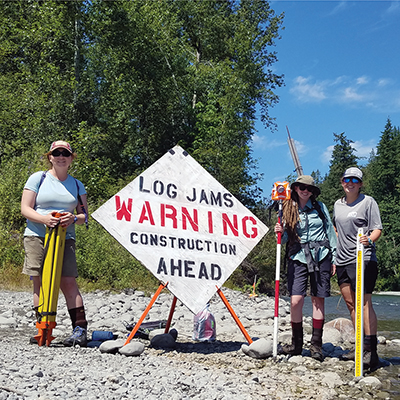Engineered log jams could be an important tool for salmon restoration
From the spring 2020 Sea Star print newsletter
By Bobbie Buzzell, WSG Science Communications Fellow
Efforts in Washington State to re-establish salmon populations and riparian habitat have been underway for quite some time—about 30 to 40 years. Yet time itself still proves to be the biggest hurdle to this work. Planting trees is essential to restoring salmon populations because roots stabilize stream banks and fallen trees create cool pools where salmon can take refuge from warm waters. However, it requires decades and even centuries for old growth forests to return and re-establish healthy vegetation alongside rivers. So, how can riparian rehabilitation be given a shorter-term “boost” while other strategies are allowed to run their course?
With funding from Washington Sea Grant (WSG), James Helfield, a professor at  Western Washington University (Western), has been studying one such solution. Engineered log jams (ELJs) are structures built from wood, sediment and other materials that are installed into rivers to increase channel stabilization and encourage the development of deep pools of cool water. These pools provide a refuge for salmon where they can take cover from predators and find shelter during periods of heightened river temperatures. ELJs are already commonly employed in restoration efforts and could become especially important for salmon in the coming years of climate change. However, the effectiveness of this method has not been well-studied until recently.
Western Washington University (Western), has been studying one such solution. Engineered log jams (ELJs) are structures built from wood, sediment and other materials that are installed into rivers to increase channel stabilization and encourage the development of deep pools of cool water. These pools provide a refuge for salmon where they can take cover from predators and find shelter during periods of heightened river temperatures. ELJs are already commonly employed in restoration efforts and could become especially important for salmon in the coming years of climate change. However, the effectiveness of this method has not been well-studied until recently.
Log jams work by redirecting stream flow, which scours the riverbed to create deep pools and an uneven topography. Variable topography promotes what is called “hyporheic exchange,” where shallow groundwater mixes with the lower layers of stream water. Hyporheic exchange sustains a stream flow resilient to temperature changes, and the consistent input of cool water is often sought out by heat-stressed salmon.
While ELJs have been used for several decades now, very little monitoring has been conducted on the boost of hyporheic exchange in these man-made pools. The Nooksack Indian Tribe began monitoring the impact of structures they had built in 2007, but their data collection was somewhat limited. Treva Coe, who manages the Habitat Program for the Nooksack Tribe, says, “We had already shown through our work that log jams form deep pools with complex cover… but our limited temperature monitoring proved inconclusive.”
With funding from WSG awarded in 2016, Helfield worked in collaboration with the Tribe to institute more robust monitoring of the ELJs that the Tribe had installed in 2016 and 2018. While the Tribe also collected pre-restoration data for a baseline, what has set this project apart from other monitoring assessments was the ability to collect more intensive, fine-scale monitoring data for both before and after ELJ implementation.
“One year of pre-restoration data is worth three years of post-restoration data,” Helfield says.
Comparing before and after periods is important for understanding the true effectiveness of restoration efforts, but these data didn’t come without some bumps in the road. The withdrawal of landowner support resulted in four fewer plots with ELJs that would have provided pre- and post-log jam data. In the end, Helfield saw a potential gain from this “happy accident.” The absence of these ELJs meant the plots could serve as controls, or rather a documentation of natural stream change where ELJs would otherwise have been installed, providing greater insight into the impacts of ELJs.
Helfield’s project also aimed to address another issue — the need to train the next generation of fisheries scientists and restoration practitioners. Students from Western were provided opportunities to build the necessary skills to do this work. Niki Aldan, one of the former technicians who graduated last June, is currently employed as a technician with the Washington Department of Natural Resources. She says the project gave her the opportunity to contribute directly to the problem solving that goes into collecting field data, which is a duty often reserved for higher ranking scientists. Sydney Jantsch, another former technician, says “I absolutely believe that the skills I acquired working on this project are something more students should acquire while an they are undergrads.” Over the course of the project, Helfield has trained 10 Western students who have all gained invaluable knowledge and expertise in proper stream assessment methods.
After several years of pre- and post-log jam data collection, the results look very promising. Most of the established ELJs have been successful in creating pockets of deep water that are actively used by salmon. “Perhaps even more important than documenting effectiveness, this project has helped characterize the mechanism by which log jams create temperature refuges,” says Coe. In the future, this kind of information could prove extremely helpful when incorporating log jam design improvements—improvements that could boost the structures’ effectiveness over time.
Although there is still some wait time involved with pool development after ELJs are installed, ELJs are a proven strategy for providing relatively immediate relief to heat-stressed fish. Paired with other short and long-term restoration methods, things might just start looking up for salmon.
APR
2020